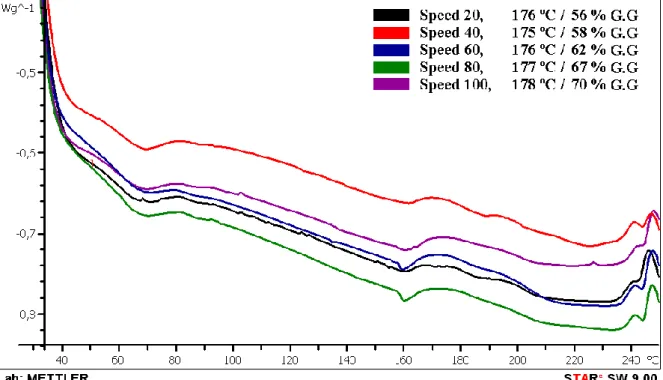IOP Conference Series: Materials Science and Engineering
PAPER • OPEN ACCESS
Effect of extrusion speed and ATO content on rheological properties of plasticised PVC
To cite this article: Ali I. Al-Mosawi and Kálmán Marossy 2019 IOP Conf. Ser.: Mater. Sci. Eng. 613 012029
View the article online for updates and enhancements.
This content was downloaded from IP address 178.164.157.117 on 04/11/2019 at 14:03
IC-CMTP5
IOP Conf. Series: Materials Science and Engineering 613 (2019) 012029
IOP Publishing doi:10.1088/1757-899X/613/1/012029
Effect of extrusion speed and ATO content on rheological properties of plasticised PVC
Ali I.Al-Mosawi 1 and Kálmán Marossy 1
1Institute of Ceramic and Polymer Engineering, University of Miskolc, Hungary E-mail: aliibrahim76@yahoo.com and polkal01@uni-miskolc.hu
Abstract. Rheological properties of antimony trioxide (ATO) modified plasticised PVC were measured at different extrusion speeds (20-100) rpm. The results showed a positive effect of the presence of ATO accompanied with increased extrusion speed, where the rheological properties and gelation grade of PVC have been improved.
1. Introduction
The extrusion speed one of the important processing parameters in addition to temperature, time, and pressure which significantly and directly affect the characteristics of the final product. The speed should not be low because the polymer will probably stick to the extruder barrel walls because the material will stay long in the extrusion cylinder in addition to the high temperature and the weakness of the flowability. Also, the speed should not increase significantly because this will generate cracks on the surface of the extruded material, and in both cases, the properties of the final product will be affected [1-4]. Due to polyvinyl chloride (PVC) considered one of the sensitive polymers; where its properties are a function of processing history, so, the extrusion speed should be controlled and balanced with high accuracy for achieving optimum properties accompany with a homogeneous structure which improves the quality of the product and reduces the deformations [5-7].
2. Methodology
The following materials have been used to produce samples: polyvinyl chloride (PVC) type Ongrovil®
S-5070, dioctyl-phthalate (DOP or DEHP) as plasticizer, calcium-zinc type Newstab-50 as heat stabilizer, Wax-E type Licowax® E as lubricant, and antimony trioxide (ATO) with (0-5) wt.%. The extrusion machine type Göttfert was used to prepare the second batch, where the material extruded to the desired shape in one step by Ø 20 extruder rod diameter at uniform pressure, compression force, and temperature. The temperatures range of the machine heaters were 140, 150, and 160 °C at a uniform rate. PVC was extruded at different speeds (20-100) rpm with and without ATO additions. DSC samples were produced according to the ISO 11357-1 standard [8] with 1mm width and 10mm thickness, and DSC test was done by Mettler Toledo DSC823e instrument to finish this test for gelation grade (G.G) measurement. The temperature range was 30 °C-240 °C; and the heating rate was 20°C/min.
3.Results and Disscusion
The gelation grade (G.G) is affected by several factors, and the most important is speed and temperature of extrusion, and the change in the gelation grade (G.G) (increase or decrease) will also affect the rate of retraction, shear stress of the polymer, the presence of cracks, and the others properties of the PVC after extrusion, where they may be improved or reduced depending on the type of filler added to the
IC-CMTP5
IOP Conf. Series: Materials Science and Engineering 613 (2019) 012029
IOP Publishing doi:10.1088/1757-899X/613/1/012029
2
percentages (1, 3, 5) %wt. respectively, where we noted that there are a significantly increments in gelation grade after adding this oxide, and the improvement rate depends on the percentage of ATO.
Figure 1. DSC traces of plasticised PVC at different extrusion speeds
Figure 2. DSC traces of 1% ATO containing plasticised PVC at different extrusion speeds
IC-CMTP5
IOP Conf. Series: Materials Science and Engineering 613 (2019) 012029
IOP Publishing doi:10.1088/1757-899X/613/1/012029
Figure 3. DSC traces of 3% ATO containing plasticised PVC at different extrusion speeds
Figure 4. DSC traces of 5% ATO containing plasticised PVC at different extrusion speeds 4.Conclusion
1. The results prove that the DSC is a speed-dependent property (process dependent).
IC-CMTP5
IOP Conf. Series: Materials Science and Engineering 613 (2019) 012029
IOP Publishing doi:10.1088/1757-899X/613/1/012029
4
Acknowledgments
We would like to thank Csaba Kónya, Gabriella Szemere, and Krisztina Tózsa at the BorsodChem Zrt., who helped us to complete this research.
References
[1] A I Al-Mosawi, K Marossy 2018 MultiScience - XXXII. microCAD International Multidisciplinary Scientific Conference 5-6 September University of Miskolc, Hungary http://doi.org/10.26649/musci.2018.017
[2] W V Titow 1990 PVC plastics properties, processing, and applications1st Edition Springer Netherlands http://doi.org/10.1007/978-94-011-3834-5
[3] D Ravoori, L Alba, H Prajapati, and A Jain 2018 Additive Manufacturing 23 132 http://doi.org/10.1016/j.addma.2018.07.011
[4] Y Deng, P Yi, L Peng, X Lai and L Zhongqin 2015 J. Micromech. Microeng. 25 (6) 065004 https://doi.org/10.1088/0960-1317/25/6/065004
[5] K Marossy 2016 Formulation International conference on the PVC industry 5-7 April Cologne, Germany
[6] D M Burke 1994 Journal of vinyl and additive technology 16 (2) 102 https://doi.org/10.1002/vnl.730160208
[7] A I Al-Mosawi, K Marossy 2018 Építőanyag-JSBCM 70 (3) 86 http://doi.org/10.14382/epitoanyag-jsbcm.2018.16
[8] ISO 11357-1:2016 2016 Plastics differential scanning calorimetry (DSC) method International Organization for Standardization
[9] W Guoquan, C Yiaoting 1991 Polymer Testing 10 (4) 315 https://doi.org/10.1016/0142-9418(91)90025-S

